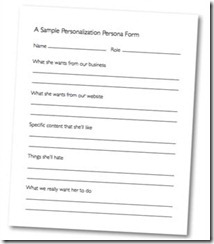Four tips for improving website personalization
Today’s savvy web visitors are increasingly looking for that ‘little something special’. To keep your content fresh, engaging and relevant to ensure a visitor returns time and time again, investment in an effective personalization strategy can take you one step closer to delivering on your goals.
I previously blogged about the 5 principles to consider for online personalization, which covered the basics of what you need to know before you get started. This post moves on to discuss the practical steps you should take before getting stuck into the execution phase.
1) Develop personalisation personas
Personas are detailed descriptions of a typical kind of website visitor. Most web developers use them when designing websites to improve navigation and usability. But personas are also very useful when planning personalization, as they will force you to really define your typical audience groups.
Think about different visitors that are likely to visit your site, for example, existing customers, prospects, partners, job-seekers or even the press, and consider what each visitor group will be looking for on your website.
A good first step to ensure that you have the right knowledge about each group is to work with persona maps and then begin building some personalization rules. Persona maps are a way of identifying a particular type of person and the individual needs they will have. Once you understand who you’re speaking to it’s much easier to start crafting a much more targeted and effective site. And it will be enable everyone in the organization to have a similar view of what your target audience is. Guaranteed to spur some discussion when you create these!
The form below is an example of a simple persona map that can be used to identify a specific user group:
2) Use what you know
Once you know your different audience groups, you need to work out how you can identify them when they visit your website. To do this, you need to use any insight or piece of data you can associate with a visitor.
This may seem challenging at first, but you probably know more than you think. The challenge is to use the right piece of data that will drive your content targeting decisions. For example:
· From their profile on your site you may know their gender, age, birthday
· From their previous interactions you know what pages they’ve viewed, what emails they’ve opened and what links they’ve clicked
· From their community activities like comments on blogs, which may give insight into their interests, level of engagement and sentiment
· From their behaviour and clickstream you can build a good idea of their intent, for example which products they have browsed
· From their IP address you can determine their location, or, in B2B, their company or industry (A note of caution: give your visitor the opportunity to change the personalization decisions you have made about them. For example, they may be in London, but could be interested in finding your stores in other parts of the UK.)
The next question to ask is: if I had data or insights on any of the above for specific personas, what content would I want this visitor to see? Or, more importantly, what content would they want to see? If you can answer these questions, a personalisation rule is born.
Clearly this is an organic process that needs to be tested. You might find that certain personalisation rules are more effective than others at driving conversions. It’s therefore important to test visitor behaviour on an ongoing basis.
3) Map content to the purchase journey
Remember, your visitors will need different things at different stages of their buying cycle, for example:
· A ‘Who We Are’ video may be perfect to engage early stage visitors
· Case studies will help convince visitors to move along the purchase funnel
· A detailed whitepaper will be of interest for those about to make a decision
Establishing where a visitor is in their relationship with your company is a useful way to personalize the information you give to them.
So, how do you know what stage they’re at?
- You can ask them in forms
- Track their forum activity
- See which web pages they’re visiting
- Observe how regularly they visit
- Establish whether they’ve responded to recent offers
- Integrate the insights with your CRM system
4) Measure success
It is only through measurement that you will be able to determine the success of your personalization strategy. To do this effectively, you need to:
· Determine tangible business value metrics, like sales and ROI
· Identify and record real-time or long-term shifts in customer behaviour
· Build teams capable of monitoring the results constantly and responding rapidly to emerging information or customer insights
Personalization programs can fizzle out quickly if your web analytics team can’t evaluate the results. So keep your personalization approach simple, quantifiable and measurable.
And remember, an effective personalization strategy is always evolving, so continuously benchmark and improve your personalization rules to increase ROI. In contrast, while you’re busily working behind the scenes, your efforts should be barely noticeable to your visitors - except in their delight in getting the information they want in the way they want it.


Comments